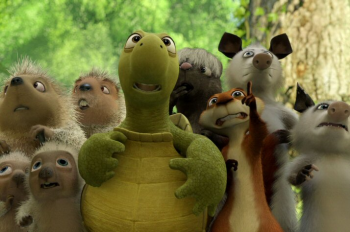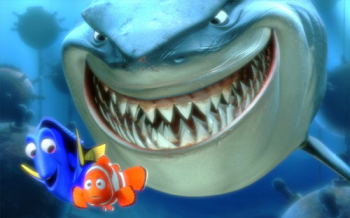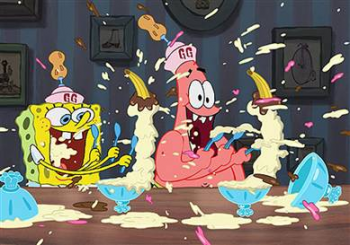Pixarvolt – Animation and Revolt
by: Judith Halberstam / University of Southern California

In contemporary animated feature films for kids, a genre I call “pixarvolt” — meaning animated movies depending upon pixar technologies of animation rather than standard linear animation and foregrounding the themes of revolution and transformation — certain topics which would never ever appear in adult films are central to the success and emotional impact of the narrative. The Pixarvolt films proceed by way of fairly conventional narratives about individual struggle, but they use the individual character only as a gateway to intricate stories of collective action, anti-capitalist critique, group bonding and alternative imaginings of community, space, embodiment and responsibility.
In the one recent film, Over The Hedge by Dreamworks, just for example, the film stages a dramatic stand off between some woodland creatures and their new junk food consuming, pollution spewing, SUV driving, trash producing, water wasting, anti-environmentalist human neighbors. As the creatures awake from their winter hibernation, they discover that while they were sleeping, a soulless suburban development stole their woodland space and the humans have erected a huge partition or hedge to fence them out. The creatures, raccoons and squirrels, porcupines and skunks, turtles and bears, band together in a cross-species alliance to destroy the colonizers, tear down the partition and to upend the suburbanites depiction of them as “vermin.” We only see the humans through the eyes of the woodland creatures and, as in countless other animated features, the humans look empty, lifeless and inert – in fact, unanimated. Over The Hedge (OTH) like other films in the Pixarvolt genre makes animation itself into a feature of kinetic political action rather than just an elaborate form of puppetry. The human and non-human then are featured as animated and unanimated rather than real and constructed or subjects and objects. The band of creatures in OTH make up a complex compendium of the non-human and they even feature a Hegelian possum who plays dead when in danger and explains to his daughter wisely: “Playing possum is what we do. We die so we may live!” Ultimately, this children’s feature offers more in the way of a vision of collective action than most independent films and critical theory put together and the film’s conclusion points to queer alliance, queer space and queer temporalities as the answers to the grim inevitability of reproductive futurity and suburban domesticity.
A short list of films that I would feature in my pixavolt genre would include: Finding Nemo, Shrek 1 and 2, Chicken Run, Babe, Wallace and Gromit, Spongebob Squarepants, Monsters Inc. and Over the Hedge. It would not include The Incredibles, Toy Story, Madagascar or Chicken Little. In the Pixavolt flicks, animated animals or odd animated human-like subjects, like Spongebob, or animated animals like Gromit who live with animated humans like Wallace, all transform our understanding of relationality, morality and social change by inhabiting worlds where common sense leads not to home-owning, or family values, or individualistic aspiration but rather the Pixavolt world is comprised of a strangely radical combination of socialist and anarchist notions mixed with odd translations of ‘animal values.’ The chickens in Chicken Run, a matriarchal group for the most part, recognize that they are not only the labor on the Tweedy farm but soon to be the product; the fish in Finding Nemo understand that the dangers of the deep are less the sharks than the fishermen; Spongebob and his buddy Patrick take on the greedy entrepreneur on the ocean’s bed; the monstrous and pathetic rejected fairytale characters in Shrek form a refugee camp outside Shrek’s swamp and so on.

Not all animated features fit the Pixarvolt bill. And so a film like The Incredibles builds its story around the supposedly heroic pathos of male mid-life crisis and invests in an Ayn Randian or scientologist notion of the special people who must not suppress their difference in order to fit in with the drab masses; the very recently released Happy Feet, similarly casts its lot in with individualism and makes a heroic figure out of the dancing penguin who cannot fit in with his sick-making, sentimentalist, heart song singing community…at first. Eventually, of course, the community expands to incorporate him but they, sadly, learn valuable lessons along the way about the importance of every single one of the rather uniform penguins learning to “be themselves.” Of course, if the penguins really were being “themselves,” that is penguins, they would not be singing Earth Wind and Fire songs in blackface as they do in the movie, and searching for soul mates, they would be making odd squawking noises and settling down for one year with one mate and then moving on!

In Over The Hedge, and other Pixavolts, desire for difference is not connected to a neo-liberal “be yourself” mentality or to special individualism for “incredible” people, rather, the Pixarvolt films connect individualism to selfishness, to untrammeled consumption and they oppose it with a collective mentality. Two thematics can transform a potential Pixarvolt film into a tame and conventional cartoon: family and romance. The Pixavolt films, unlike their un-revolting conventional animation counterparts, seem to know that their main audience is children and they seem to also know that children do not invest in the same things that adults invest in: children are not coupled, they are not romantic, they do not have a religious morality, they are not afraid of death, they are collective creatures, they are in a constant state of rebellion against their parents and they are not the masters of their domain. Children stumble, bumble, fail, fall, hurt; they are mired in difference, not in control of their bodies, not in charge of their lives and they live according to schedules not of their own making. The Pixavolt films offer the child an animated world of triumph for the little guys, a revolution against the business world of the father and the domestic sphere of the mother – in fact, very often, the mother is simply dead and the father is enfeebled (as in Robots, Monsters Inc., Finding Nemo, and Over The Hedge). Gender in these films is shifty and ambiguous (transsexual fish in Finding Nemo, other-species-identified pig in Babe); sexualities are amorphous and polymorphous (the homoerotics of Spongebob and Patrick’s relationship and of Wallace and Gromit’s domesticity); class is clearly marked in terms of labor and species diversity and bodily ability is quite often at issue (Nemo’s small fin, Shrek’s giganticism). While recent animations tend to be all too unrevolting (see aforementioned Happy Feet but also Flushed Away), the genre itself seems to have made a commitment to the quirky, the rebellious and the queer and while Happy Feet danced the new penguin chic all the way to the bank, perhaps there’s another grim and less cheery animation in the making, one where dancing penguins give way to more of the unsettling and perverse animal narratives that we have come to love and trust.
Images
2. Finding Nemo
Please feel free to comment.
I’d be interested to see who is producing these films. As Julia Mickenberg and other scholars have documented, a lot of children’s books from the Cold War period were written but people who had been blacklisted as communists. I doubt that the politics of these pictures are far removed from those of the people working on the production end of things. Why is it that cultural products for children are assumed to exist in de-politicized zones, when they tend to be equally if not more political than their adult-targeted counterparts? After all, most children’s stories from all periods function as morality tales of one kind or another.
These days I come to children’s films through the lens that my four year twin nieces provide. Having watched most of these films with them, it does seem to me that whether the film stresses individuality (as with the Incredibles) or the group (as with Over The Hedge) these children are most interested in the relationships between the characters. This may be because they are still working to understand the various ways that people in their lives are connected to each other (as in, “Mom, your husband is on the phone.”) or because they are so dependent on others, but they stress the group even when the film doesn’t. Group politics seem to be the ones that matter to them. I wonder whether this might make those films that emphasize groups more effective in teaching than the others? If, as Halberstam suggests, these films meet them where they are, then they might be more open to those lessons.
Wow, watching Skrek3 with the kids and it is truly discusting. I am 54 yrs old. Seeing female characters with male voices, and other left wing, alternate lifestyle insinuations is enough to make me vomit, and I live in this crazy Los Angeles. This is such a contrast to Rat-a-tuti movie that I really enjoyed with my 17 yr old son last evening. Makes me think in terms of Dreamworks equals trash and Pixar equals brilliant humor and creativity. So I do not know what Pixarvolt is, or if it is related to Pixar, I need to research this. But maybe the whole industry is left and queer, but wow what a change from bugs bunny!
Pingback: Ardentfrost » 2 Movies: Wall-E and Akira
Dunno if the author will ever notice this note, but perhaps it should be noted that the word “Pixar” is in fact the name of a particular movie studio, and is not a generic term for computer-generated animation.
To any future readers: “reader”‘s comment should be disregarded. While technically true, the point of this article is to summarize the chapter “Animating Revolt and Revolting Animation” from _The Queer Art of failure_ by Jack/Judith Halberstam, which it did (for the most part) very well.
Halberstam does indeed lump all “Pixarvolt”-like films together regardless of whomever did the actual studio production, by it Pixar, Dreamworks, or even Nickelodeon.
Admittedly I haven’t seen every episode of Spongebob but I don’t think it was that bad. I know Mr. Krabs is made out to be bad for being a greedy business owner or whatever but I’m not sure it was that big of a deal. Greedy characters aren’t anything new…